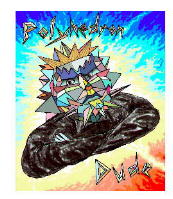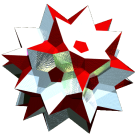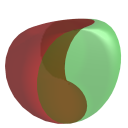|
Acronym
|
tet
|
|
TOCID symbol
|
T, (2)Q
|
|
Name
|
tetrahedron,
3D simplex (α3),
pyrochor(id),
regular trigonal pyramid,
digonal antiprism,
regular (di)sphenoid,
hemicube,
smaller Delone cell of face-centered cubic (fcc) lattice,
regular line-scalene,
regular (point-)tettene,
vertex figure of pen,
Gosset polytope 02,
Waterman polyhedron number 1 wrt. face-centered cubic lattice A3 centered at a shallow hole
|
|
|,>,O device
|
line pyramid pyramid = |>>
|
|
VRML
|
⭳ ©
|
|
Circumradius
|
sqrt(3/8) = 0.612372
|
|
Edge radius
|
1/sqrt(8) = 0.353553
|
|
Inradius
|
1/sqrt(24) = 0.204124
|
|
Vertex figure
|
[33] = x3o
|
Snub derivation /
VRML
|
⭳
|
|
Vertex layers
|
| x3o3o | x3o .
{3} first | x . o
edge first | . o3o
vertex first |
o3o .
opposite vertex | o . x
opposite edge | . x3o
vertex figure
opposite {3} |
|
Lace city
in approx. ASCII-art
|
o
x o
|
|
Coordinates
|
(1/sqrt(8), 1/sqrt(8), 1/sqrt(8)) & all permutations, all even changes of sign
|
|
Volume
|
sqrt(2)/12 = 0.117851
|
|
Surface
|
sqrt(3) = 1.732051
|
|
Rel. Roundness
|
π sqrt(3)/18 = 30.229989 %
|
|
General of army
|
(is itself convex)
|
|
Colonel of regiment
|
(is itself locally convex
– no other uniform polyhedral members)
|
|
Dual
|
(selfdual, in different orientation)
|
|
Dihedral angles
|
- between {3} and {3}: arccos(1/3) = 70.528779°
|
|
Face vector
|
4, 6, 4
|
|
Confer
|
- more general:
-
xPoPo
n/d-py
n/d-ap
- variations:
-
xo ox&#q
xo oq&#q
ho oh&#q
xo ox&#h
qo oq&#h
qo ou&#h
uo ou&#h
xo ox&#k
xo3oo&#q
qo3oo&#x
qo3oo&#h
- Grünbaumian relatives:
-
2tet
3tet
4tet
6tet
- blends:
-
tridpy
- compounds:
-
so
ki
e
sis
snu
dis
- general polytopal classes:
-
Wythoffian polyhedra
Catalan polyhedra
deltahedra
regular
noble polytopes
simplex
scalene
tettene
partial Stott expansions
segmentohedra
fundamental lace prisms
lace simplices
Coxeter-Elte-Gosset polytopes
- analogs:
-
regular simplex Sn
birectified simplex brSn
demihypercube Dn
rectified simplex pyramid rSn-py
|
External
links
|






|
The number of ways to color the tetrahedron with different colors per face is 4!/12 = 2. –
This is because the color group is the permutation group of 4 elements and has size 4!,
while the order of the pure rotational tetrahedral group is 12. (The reflectional tetrahedral group would have twice as many, i.e. 24 elements.)
3D simplices with 3 alike faces are trigonal pyramids (which thus is describable by ox3oo&#y).
Those with 2 alike faces are sphenoids. Those with 2 pairs of alike faces then are disphenoids.
The (regular) tetrahedron hence is just a special case of all these.
More specially some authors even want to distinguish the various types of those disphenoids by means of additional attributions:
a tetragonal disphenoid will have four identical isosceles triangles (which thus is describable by xo ox&#y or as digonal antiprism of arbitrary height),
a digonal disphenoid has two types of isosceles triangles (which thus is xo oy&#z),
a rhombic disphenoid has four identical scalene triangles, and
a phyllic disphenoid has two types of scalene triangles, i.e. the latter two just are chiral versions of the formers.
Somehow off-topic there are some neet number relations between the tet and the oct:
-
face count ratio: Foct / Ftet = 8/4 = 2
-
face type: noct = ntet = 3 (triangles each)
-
radius ratio: (circumradiusoct / inradiusoct)2 = circumradiustet/inradiustet = 3
-
volume ratio: Voct / Vtet = 2
Incidence matrix according to Dynkin symbol
x3o3o
. . . | 4 | 3 | 3
------+---+---+--
x . . | 2 | 6 | 2
------+---+---+--
x3o . | 3 | 3 | 4
snubbed forms: β3o3o
x3o3/2o
. . . | 4 | 3 | 3
--------+---+---+--
x . . | 2 | 6 | 2
--------+---+---+--
x3o . | 3 | 3 | 4
snubbed forms: β3o3/2o
x3/2o3o
. . . | 4 | 3 | 3
--------+---+---+--
x . . | 2 | 6 | 2
--------+---+---+--
x3/2o . | 3 | 3 | 4
snubbed forms: β3/2o3o
x3/2o3/2o
. . . | 4 | 3 | 3
----------+---+---+--
x . . | 2 | 6 | 2
----------+---+---+--
x3/2o . | 3 | 3 | 4
snubbed forms: β3/2o3/2o
s4o3o
demi( . . . ) | 4 | 3 | 3
--------------+---+---+--
s4o . ♦ 2 | 6 | 2
--------------+---+---+--
sefa( s4o3o ) | 3 | 3 | 4
starting figure: x4o3o
s2s4o
demi( . . . ) | 4 | 2 1 | 3
--------------+---+-----+--
s2s . ♦ 2 | 4 * | 2
. s4o ♦ 2 | * 2 | 2
--------------+---+-----+--
sefa( s2s4o ) | 3 | 2 1 | 4
starting figure: x x4o
s2s2s
demi( . . . ) | 4 | 1 1 1 | 3
--------------+---+-------+--
s2s . ♦ 2 | 2 * * | 2
s 2 s ♦ 2 | * 2 * | 2
. s2s ♦ 2 | * * 2 | 2
--------------+---+-------+--
sefa( s2s2s ) | 3 | 1 1 1 | 4
starting figure: x x x
xo3oo&#x → height = sqrt(2/3) = 0.816497
({3} || pt)
o.3o. | 3 * | 2 1 | 1 2
.o3.o | * 1 | 0 3 | 0 3
---------+-----+-----+----
x. .. | 2 0 | 3 * | 1 1
oo3oo&#x | 1 1 | * 3 | 0 2
---------+-----+-----+----
x.3o. | 3 0 | 3 0 | 1 *
xo ..&#x | 2 1 | 1 2 | * 3
xo ox&#x → height = 1/sqrt(2) = 0.707107
(line || perp line)
o. o. | 2 * | 1 2 0 | 2 1
.o .o | * 2 | 0 2 1 | 1 2
---------+-----+-------+----
x. .. | 2 0 | 1 * * | 2 0
oo oo&#x | 1 1 | * 4 * | 1 1
.. .x | 0 2 | * * 1 | 0 2
---------+-----+-------+----
xo ..&#x | 2 1 | 1 2 0 | 2 *
.. ox&#x | 1 2 | 0 2 1 | * 2
oxo&#x → height(1,2) = height(2,3) = sqrt(3)/2 = 0.866025
height(1,3) = 1
( (pt || line) || pt)
o.. | 1 * * | 2 1 0 0 | 1 2 0
.o. | * 2 * | 1 0 1 1 | 1 1 1
..o | * * 1 | 0 1 0 2 | 0 2 1
-------+-------+---------+------
oo.&#x | 1 1 0 | 2 * * * | 1 1 0
o.o&#x | 1 0 1 | * 1 * * | 0 2 0
.x. | 0 2 0 | * * 1 * | 1 0 1
.oo&#x | 0 1 1 | * * * 2 | 0 1 1
-------+-------+---------+------
ox.&#x | 1 2 0 | 2 0 1 0 | 1 * *
ooo&#x | 1 1 1 | 1 1 0 1 | * 2 *
.xo&#x | 0 2 1 | 0 0 1 2 | * * 1
oooo&#x → all pairwise heights = 1
o... | 1 * * * | 1 1 1 0 0 0 | 1 1 1 0
.o.. | * 1 * * | 1 0 0 1 1 0 | 1 1 0 1
..o. | * * 1 * | 0 1 0 1 0 1 | 1 0 1 1
...o | * * * 1 | 0 0 1 0 1 1 | 0 1 1 1
--------+---------+-------------+--------
oo..&#x | 1 1 0 0 | 1 * * * * * | 1 1 0 0
o.o.&#x | 1 0 1 0 | * 1 * * * * | 1 0 1 0
o..o&#x | 1 0 0 1 | * * 1 * * * | 0 1 1 0
.oo.&#x | 0 1 1 0 | * * * 1 * * | 1 0 0 1
.o.o&#x | 0 1 0 1 | * * * * 1 * | 0 1 0 1
..oo&#x | 0 0 1 1 | * * * * * 1 | 0 0 1 1
--------+---------+-------------+--------
ooo.&#x | 1 1 1 0 | 1 1 0 1 0 0 | 1 * * *
oo.o&#x | 1 1 0 1 | 1 0 1 0 1 0 | * 1 * *
o.oo&#x | 1 0 1 1 | 0 1 1 0 0 1 | * * 1 *
.ooo&#x | 0 1 1 1 | 0 0 0 1 1 1 | * * * 1



